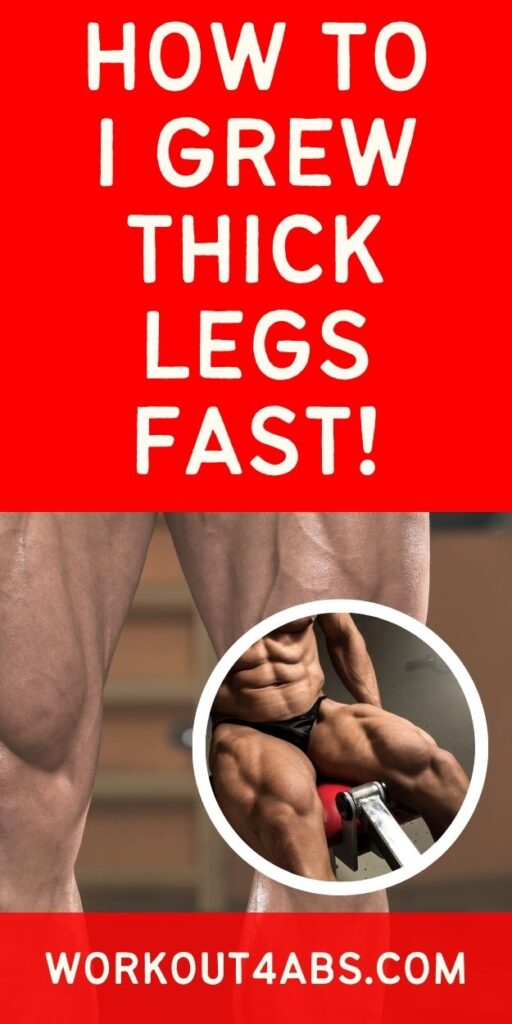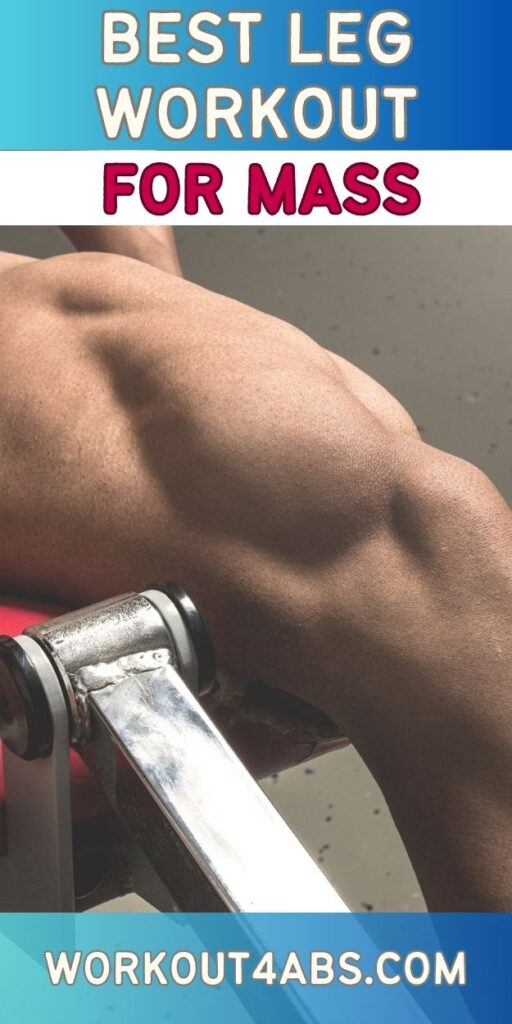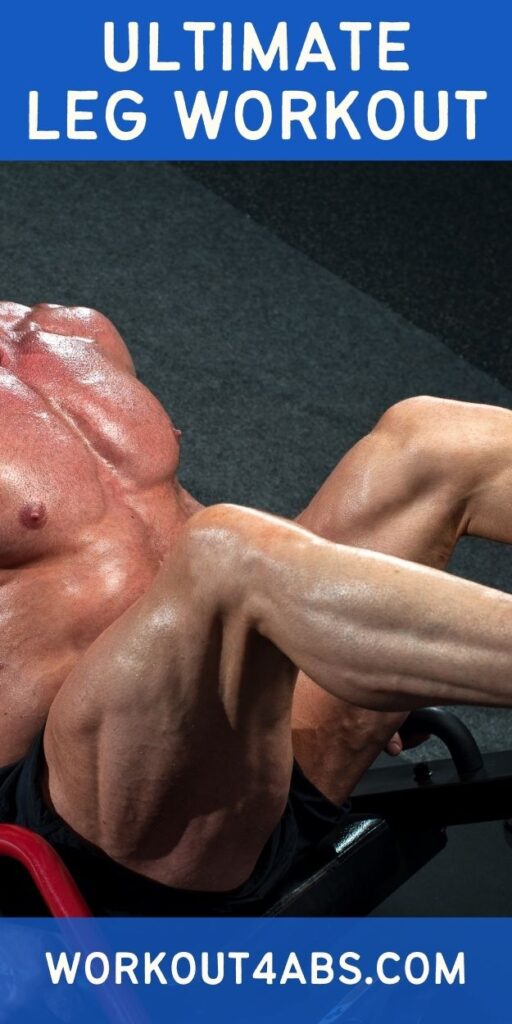Here’s a thick thighs workout for your pursuit of powerful and robust thigh muscles. This article unveils the top five exercises that will help you sculpt and strengthen your thigh muscles for that coveted thick and muscular lower body. Let’s dive into the transformative world of leg day workouts.
How I Grew Thick Legs…FAST!
If you enjoyed these tips, please save this pin to your Pinterest Board.

Seated Hamstring Curls
Seated hamstring curls are a great exercise for targeting and building muscle mass in the hamstrings, the muscles on the back of your thighs. Here’s a step-by-step guide on how to perform seated hamstring curls effectively:
Equipment Needed:
- Seated leg curl machine: You’ll need access to a gym or fitness facility with this specific machine.
Instructions:
- Set Up:
- Adjust the machine: Start by adjusting the machine to your body size. Depending on the machine, you may need to adjust the seat height and the positioning of the leg pad.
- Sit down: Sit on the machine with your back straight and your feet firmly on the footrest.
- Adjust the weight: Select an appropriate weight by inserting the pin in the weight stack that matches your fitness level.
- Leg Position:
- Position your legs: Place the backs of your lower legs against the leg pad, just above your ankles. Your knees should be slightly off the edge of the seat.
- Grip the handles: If the machine has handles or grips, hold onto them for stability and support.
- Execution:
- Start the movement: Begin by exhaling and flexing your knees, curling your lower legs upward toward your glutes while keeping your upper legs against the seat.
- Contract the hamstrings: Focus on using your hamstrings to perform the movement. Avoid using momentum or your lower back to lift the weight.
- Hold for a second: At the top of the movement, when your lower legs are near your glutes, hold the contraction for a brief moment while squeezing your hamstrings.
- Inhale and return: In a controlled manner, slowly lower your lower legs back to the starting position while inhaling. Keep the tension on your hamstrings as you do this.
- Repetitions and Sets:
- Aim for 3-4 sets of 8-12 repetitions. This rep and set range is generally effective for building muscle mass.
- Start with a weight that allows you to complete your desired number of reps with good form. Gradually increase the weight as you get stronger.
- Safety Tips:
- Maintain proper form throughout the exercise to prevent injury. Keep your back straight and avoid arching or rounding it.
- Do not use momentum to lift the weight; the movement should be controlled.
- Use a full range of motion, but do not hyperextend your knees at the bottom of the movement.
- If you’re new to this exercise, consider seeking guidance from a fitness professional to ensure proper form and technique.
Remember that building muscle mass takes time and consistency. Include seated hamstring curls as part of a well-rounded leg workout routine, and be sure to also incorporate other leg exercises for balanced muscle development. Additionally, make sure to follow a proper diet and get enough rest for optimal muscle growth.
If you enjoyed these tips, please save this pin to your Pinterest Board.

Hack Squats
The hack squat is an effective compound exercise that primarily targets the quadriceps, hamstrings, and glutes, helping you build muscle mass in your legs. Here’s a step-by-step guide on how to perform the hack squat exercise correctly:
Equipment Needed:
- Hack squat machine: You’ll need access to a hack squat machine, typically found in most gyms.
Instructions:
- Set Up:
- Adjust the machine: Start by adjusting the machine to your body size. This may involve setting the shoulder pads and the foot platform to the appropriate height.
- Load the machine: Add weight plates to the machine’s weight stack according to your fitness level. The weight should be challenging but manageable.
- Starting Position:
- Stand facing the machine, with your back against the backrest and your shoulders securely placed under the shoulder pads.
- Position your feet shoulder-width apart on the foot platform, with your toes slightly pointing outward.
- Ensure your back is straight, chest is up, and your core is engaged for stability.
- Execution:
- Unlock the safety bars or handles on the machine, depending on the design.
- Inhale and slowly lower your body by bending your knees. Keep your chest up and your back against the pad as you lower yourself.
- Lower yourself until your thighs are parallel to the ground or as far as your flexibility allows. Avoid letting your knees go past your toes.
- Hold for a brief moment at the bottom of the squat to maximize muscle engagement.
- Exhale and push through your heels to extend your legs and return to the starting position. Keep your back pressed against the pad and maintain control throughout the movement.
- Repetitions and Sets:
- Aim for 3-4 sets of 8-12 repetitions. This rep and set range is generally effective for building muscle mass.
- Start with a weight that allows you to complete your desired number of reps with proper form. Gradually increase the weight as you get stronger.
- Safety Tips:
- Keep your knees in line with your toes throughout the movement to protect your knees.
- Do not lock out your knees at the top of the movement; keep a slight bend to maintain tension in the muscles.
- Use controlled movements and avoid bouncing at the bottom of the squat.
- If you’re new to the hack squat or have any concerns about your form, consider seeking guidance from a fitness professional.
- Variations:
- You can vary your foot placement (wide, narrow, high, low) to target different areas of your leg muscles.
- Experiment with different rep ranges and tempos to add variety to your leg workouts and stimulate muscle growth.
As with any exercise, proper form is crucial to prevent injury and maximize muscle development. Start with lighter weights to master the movement, and gradually increase the load as your strength improves. Incorporate hack squats into your leg workout routine along with other leg exercises for balanced leg muscle development.
Split Squats
Split squats, also known as stationary lunges, are an excellent exercise for building muscle mass in the legs, particularly the quadriceps, hamstrings, and glutes. Here’s a step-by-step guide on how to perform split squats correctly:
Equipment Needed:
- None required, but you can use dumbbells or a barbell to add resistance as you progress.
Instructions:
- Starting Position:
- Stand up straight with your feet hip-width apart.
- Take a step forward with one foot (the working leg) and a step back with the other (the supporting leg).
- Keep your chest up, shoulders back, and your core engaged for stability.
- Execution:
- Begin by lowering your body straight down, bending both knees to about 90-degree angles. Your front knee should be directly above your front ankle.
- Lower yourself until your back knee is almost touching the ground or hovers slightly above it. Ensure your back knee is just a few inches from the ground and does not slam into it.
- Keep your upper body upright and your torso as straight as possible throughout the movement.
- Exhale as you push through your front heel to return to the starting position, extending your knees and hips.
- Repeat the movement for the desired number of reps.
- Repetitions and Sets:
- Aim for 3-4 sets of 8-12 repetitions per leg. This rep and set range is generally effective for building muscle mass.
- Start without added weight and progress to using dumbbells or a barbell as you get stronger.
- Safety Tips:
- Ensure your front knee does not go past your front toes during the movement to protect your knee joint.
- Keep your chest up and your back straight to avoid leaning forward excessively.
- Engage your core muscles to stabilize your body during the exercise.
- Maintain a controlled and smooth pace throughout the movement, avoiding any jerking or sudden movements.
- Variations:
- To add variety and increase difficulty, you can perform Bulgarian split squats, which involve elevating your back foot on a bench or platform.
- You can also use dumbbells or a barbell for added resistance as you progress in strength.
Split squats are a versatile exercise that can be included in your leg workout routine to target different areas of your legs. They are effective for building muscle mass, improving balance, and enhancing lower body strength. As with any exercise, start with proper form and gradually increase the intensity to see the best results while minimizing the risk of injury.
Leg Extensions
Leg extensions are a targeted isolation exercise that primarily work the quadriceps muscles in the front of your thighs. They can help build muscle mass in the quads when performed correctly. Here’s a step-by-step guide on how to do leg extensions:
Equipment Needed:
- Leg extension machine: You’ll need access to a leg extension machine, commonly found in most gyms.
Instructions:
- Set Up:
- Adjust the machine: Start by adjusting the machine to your body size. This typically involves adjusting the seat height and the position of the leg pad.
- Sit down on the machine and adjust the seat so that your back is fully supported and your knees align with the pivot point of the machine.
- Adjust the weight: Select an appropriate weight by inserting the pin in the weight stack. Choose a weight that allows you to perform your desired number of repetitions with proper form.
- Leg Position:
- Position your legs: Place your legs under the leg pad, with the pad positioned just above your ankles.
- Ensure your feet are pointed forward, and your toes are relaxed.
- Hold onto the handles of the machine for support and stability.
- Execution:
- Inhale and brace your core for stability.
- Exhale as you extend your legs fully, pushing against the resistance of the machine. This movement should be isolated to your knees and should not involve your hips or upper body.
- At the top of the movement, when your legs are fully extended, hold for a brief moment to contract and engage your quadriceps muscles.
- Inhale as you lower the weight in a controlled manner, returning to the starting position. Keep the tension on your quads throughout the entire range of motion.
- Repetitions and Sets:
- Aim for 3-4 sets of 8-12 repetitions. This rep and set range is generally effective for building muscle mass in the quadriceps.
- Start with a weight that allows you to complete your desired number of reps with proper form. Gradually increase the weight as you get stronger.
- Safety Tips:
- Maintain proper form throughout the exercise to prevent injury. Keep your back against the backrest, and avoid arching or rounding it.
- Use a full range of motion, extending your legs fully at the top of the movement without locking your knees.
- Avoid using momentum to lift the weight; the movement should be controlled and deliberate.
- If you’re new to this exercise, consider seeking guidance from a fitness professional to ensure proper form and technique.
Leg extensions can be a valuable addition to your leg workout routine for targeting and developing your quadriceps muscles. However, it’s essential to perform them with proper form, control, and an appropriate weight to minimize the risk of injury and maximize muscle growth.
Backward Treadmill Walk
The backward treadmill walk is a unique and effective exercise that can help build muscle mass in the legs, particularly in the quadriceps, hamstrings, glutes, and calves. Walking backward on a treadmill challenges your muscles in a different way compared to forward walking or running. Here’s how to do it:
Instructions:
- Treadmill Setup:
- Start by selecting a treadmill with a safety handle or railings on both sides. Safety is crucial, as walking backward can be disorienting.
- Stand on the treadmill belt facing backward, with your feet shoulder-width apart.
- Safety Precautions:
- Hold onto the railings or safety handlebars to maintain your balance and stability.
- Start the treadmill at a very slow speed (usually 0.5 to 1.0 mph) to get accustomed to walking backward safely.
- Posture and Movement:
- Keep your chest up and shoulders back to maintain proper posture.
- Start walking backward by taking small, controlled steps.
- Keep your eyes on the treadmill’s display screen or on a spot in front of you to help with balance and orientation.
- Focus on lifting your feet high enough to clear the edge of the treadmill belt without tripping.
- Increasing Difficulty:
- As you become more comfortable with backward walking, you can gradually increase the speed on the treadmill.
- You can also experiment with walking on an incline if your treadmill has that feature. An incline will increase the intensity and target your leg muscles even more.
- Duration:
- Perform the backward treadmill walk for a duration that matches your fitness level and goals. You can start with 5-10 minutes and gradually increase the time as you progress.
How Backward Treadmill Walking Builds Muscle Mass:
- Engages Different Muscle Groups: Walking backward challenges different muscle groups than forward walking or running. It places a greater emphasis on the quadriceps, hamstrings, and glutes, as you need these muscles to push off and control your movements.
- Strengthens Stabilizing Muscles: Balancing and maintaining stability during backward walking engage your smaller stabilizing muscles, helping to improve overall leg strength and coordination.
- Variation for Muscle Confusion: Incorporating backward walking into your routine can be a form of “muscle confusion,” which can help prevent plateaus in muscle growth. It’s a novel movement that can stimulate muscle growth by challenging your muscles in a new way.
- Low Impact: Unlike high-impact activities like running, backward treadmill walking is relatively low-impact, making it a suitable choice for those with joint issues or as a recovery exercise.
Remember to start at a slow pace and gradually increase both speed and duration as you become more comfortable and confident with the movement. Always prioritize safety and use the handrails for support until you are comfortable with the exercise. It’s also a good idea to consult with a fitness professional or healthcare provider before incorporating new exercises into your routine, especially if you have any pre-existing medical conditions or concerns.
If you enjoyed these tips, please save this pin to your Pinterest Board.

Home › Aesthetic Body Plan ›Thick Thighs Workout